Biology Quiz 4 - full set
1/141
There's no tags or description
Looks like no tags are added yet.
Name | Mastery | Learn | Test | Matching | Spaced |
|---|
No study sessions yet.
142 Terms
Trophic control
top down and bottom up control methods
Bottom-up mechanisms
producers influence other species (resources controlling trophic levels)
trophic cascade
Disruption of a food web by loss or reduction in abundance by one or more of its members
Top-down mechanisms
consumption of lower trophic levels. This can be through herbivory, parasites, or viruses, not just predation.
More predators leads to
a richer food web.
Eutrophication
excessive richness of nutrients in a lake or other body of water, frequently due to runoff from the land, which causes a dense growth of plant life and death of animal life from lack of oxygen. Causes algal blooms
Human Induced problems in trophic control
Bottum up: Eutrophication and algal blooms
Top-Down: Introducing invasive predators
Peduzzi Paper
Flamingos ate cyanobacteria which were being infected by virus. The cyanophages infect the cyanocacteria and reduce the population of the cyanobacteria which reduces the food source for the flamingo.
Flamingo abundance was measured via transects, Cyanobacteria measured via water sampling (distinct curl) and the cyanophages were measured via fluorescence and "Frequency of Visibly Infected Cells" or FVIC.
LUCA
Last Universal Common Ancestor
taxonomics
The study of naming, describing, and classifying organisms.
Systematics
study of the pattern of relationships among taxa. categorization of ALL LIFE, and also the reconstruction of the pattern of events that has led to the distribution and diversity of life.
Phylogeny
A hypothesis of how taxa are evolutionarily related to each other.
Node
Where branches split. Denotes common ancestor.
Phylogentetic tree mirrors what?
The speciation proceess
CLADE
evolutionary branch of a cladogram that includes a single ancestor and all its descendants.
All organisms IN a clade are more closely related to each other than to any taxon outside of the clade
monophyletic clade
a common ancestor and all of its descendants
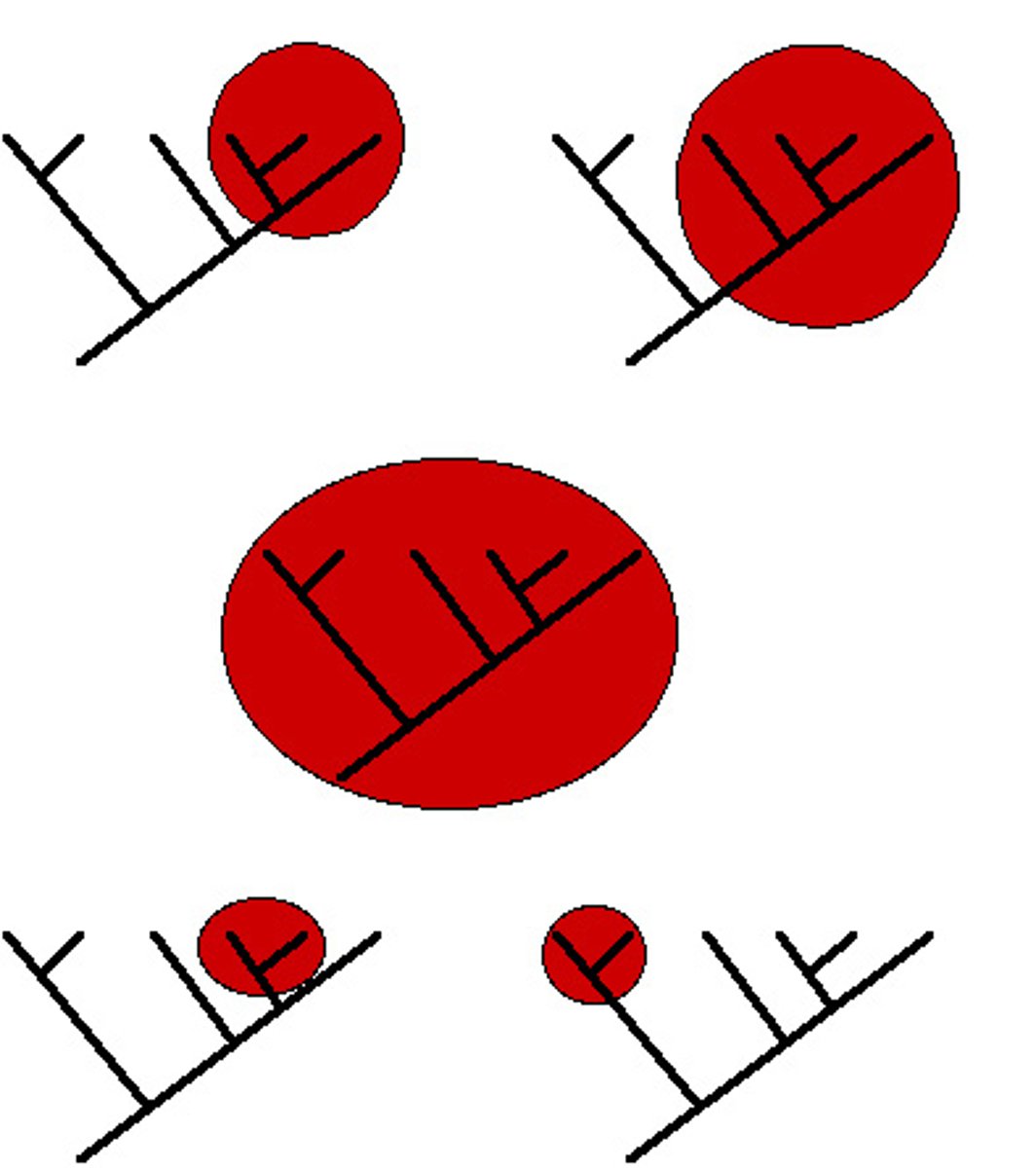
polyphyletic clade
Shares similar traits but does not include the most recent common ancestor

paraphyletic clade
includes an ancestral population and some of its descendants, but not all
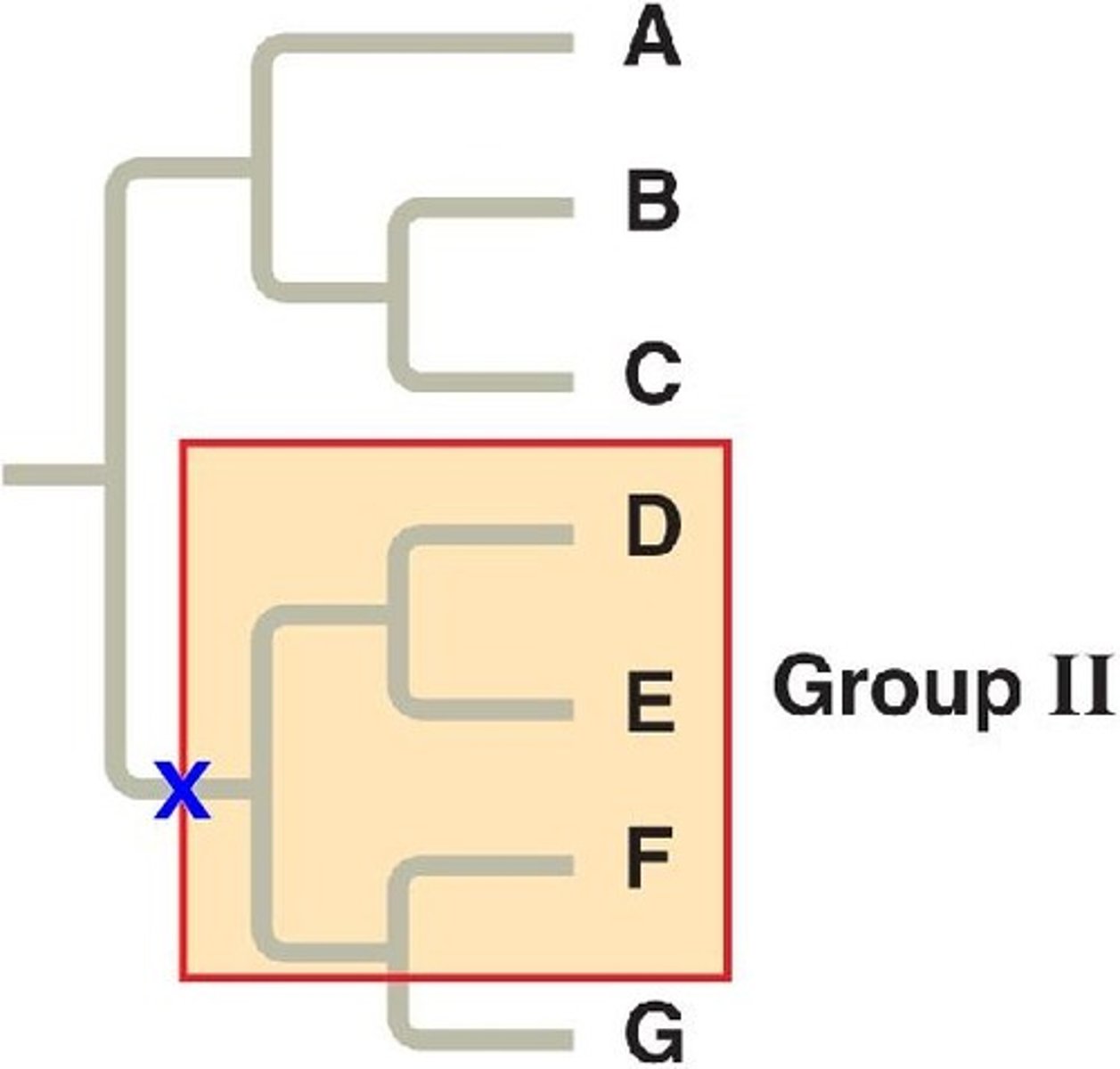
outgroup
closest species to the clade that is not in the clade
What evidence is used to make phylogenetic trees?
Shared History: Traits (physical, chemical, behavioral) and DNA
Parsimony
Arrangement of taxa that requires the fewest changes and is thus the most likely.
Synapomorphy
Trait shared by two or more taxa, that was present in their most recent common ancestor.
molecular clock
Use of mutation rates in DNA to estimate the length of time that two species have been evolving independently
Advatnages of using DNA sequences to make a tree
•High variation and easily quantifiable
•Follows evolutionary history (avoids convergence)
•Mutates at a steady background rate: length of branches roughly correlated to time since split
Advantages of using physical traits to make a tree
Easily observable without sequencing technology
homologous trait
any characteristic which is derived by evolution from a common ancestor
analogous trait
similarities between organisms that were evolved separately.
divergence
closely related species evolve different traits due to selection by different environments
convergence
distantly related species evolve similar traits because of similar environmental selection pressures
Requirements for data when creating a phylogenetic tree
Data must be morphological or molecular (and occasionally behavioral, developmental, physiological)
Traits must be homologous across all taxa being studied
Traits must vary across the taxa you’re studying.
A phylogenetic study must identify an outgroup
Character States
is trait present or absent
Organ paper
Which came first, flight or small genome size?
Compare and contrast osteocyte-cell size and genome size in both ornithischian and saurischian dinosaurs, as well as extant tetrapod species such as birds. This is done to observe the connection between genome and osteocyte-cell sizes in extinct dinosaur species to the small genome sizes in the birds that evolved from them.
LINEs and SINEs
these are interspersed nucleur elements that can move around the genome which leads to mutations which will infleunce natural selcetion.
these are effective synapomorphies because they generate heritable variation at the genomic level.
Do humans have more prokaryotic cells in them or more eukaryotes?
prokaryotes
Key features of bacteria and archea
-Morphological diversity
-Metabolic diversity
-Horizontal gene transfer
Are prokaryotes mono, para, or poly phyletic?
paraphyletic
Bacteria
single-celled, microscopic organisms that lack a nucleus and are classified as prokaryotes. They can be found in nearly every environment on Earth and play essential roles in processes like nutrient cycling, digestion, and disease
Archaea
single-celled microorganisms that, like bacteria, lack a nucleus but have distinct genetic and biochemical traits. They often thrive in extreme environments, such as hot springs, salt lakes, and deep-sea vents, and play key roles in biogeochemical cycles
Bacteria vs. Archaea
Bacterial cell walls contain peptidoglycan
Archaea have phospholipids made from isoprene in their membrane
Transcription is different
Antibiotics that work on bacteria most likely won't work on archaea
Value of studying prokaryotes
Vast evolutionary history.
Lots of uncatalogued diversity!
Many important jobs are done by Bacteria & Archaea
Decomposition, nutrient cycling
key features of bacteria and archaea (evolutionary innovations and diversity)
-Morphological diversity
-Metabolic diversity
-Horizontal gene transfer
_______ diversity is to prokaryotes what multiceullar diversity is to eukaryotes
metabolic
photoautotroph (plants, cyanobacteria, algae)
carbon from CO2, energy from the sun
chemoautotroph (unique to prokaryotes, harsh conditions)
carbon from CO2, energy from environment
photoheterotrophs (heliobacteria)
carbon from environment, energy from sunlight
chemoheterotroph (animals, bacteria, fungi)
carbon from the environment, energy from the environment
bacterial genomes are smaller because
they lack non-coding DNA
Why can't bacteria be categorized using BSC
Asexual reproduction
Horizontal gene transfer (HGT)
Reproductive isolation isn't meaningful
horizontal gene transfer
when prokaryotes are able to transfer genes from one cell to another completely asexually this process involves conjugation, transduction, transformation
Astriobiology
The study of extremophiles informs predictions where life could be possible on other planets.
Protists
unicellular (sometimes multicellular), often aquatic or marine, with a membrane-bound nucleus, linear DNA, internal membranes, motility via cilia, flagella, or amoeboid motion, and reproduce both sexually and asexually.
or JUST
All Eukaryotes that are not plants, fungi, or animals
Value of studying protists: medical
protists can be transmitted by moquitos (chagas disease),
value of studying protists: ecological
principle primary producers in oceans, protsits create calcified carbon which leads to a huge carbon sink and hard strcutures on the ocean floor.
Protozoan
informal term for a group of unicellular eukaryotes that feed on organic matter as free living or parasites
Diatoms
(unicellular) The most diverse stramenopiles with around 10,000 described species, are non-motile, have glass-like cell walls, serve as a major marine food source, and as key members of phytoplankton contribute to about 25% of the world's photosynthesis.

top down regulation of bacteria by protists
Protists use diverse feeding adaptations like cilia or piercing structures to consume bacteria, increases nitrogen availability to plants through nutrient turnover and drives Red-Queen coevolutionary interactions between protists and bacteria.
key features of protists
Nuclear envelope, Mitochondria, Eukaryotic flagellum, alveoli (airsacks for gas exchange) PARAPHYLETIC GROUP
how did protsists get a nuclear envelope?
infolding of plasma membrane (also ER appears around nuclear membrane)
what two organelles have their own DNA
mitochondria and chloroplasts
primary endosymbiosis (two approaches
1. A primitive prokaryotic cell (probably an archaeon) engulfed another prokaryotic cell—specifically, a proteobacterium—and instead of digesting it, the two cells formed a symbiotic relationship. Led to mitochondria.
2. The engulfment of a cyanobacterium by a larger eukaryotic cell that gave rise to the first photosynthetic eukaryotes with chloroplasts.
Are there chloroplasts in protists?
YES! diatoms, dinoflagellates, & brown algae
secondary endosymbiosis
a process in eukaryotic evolution in which a heterotrophic eukaryotic cell engulfed a photosynthetic eukaryotic cell which survived in a symbiotic relationship inside the heterotrophic cell
Opisthokonta: Choanoflagellates
sister clade to animals; unicellular or colonial; aquatic; colonial form resembles sponges; catch food with flagellum surrounded by collar;
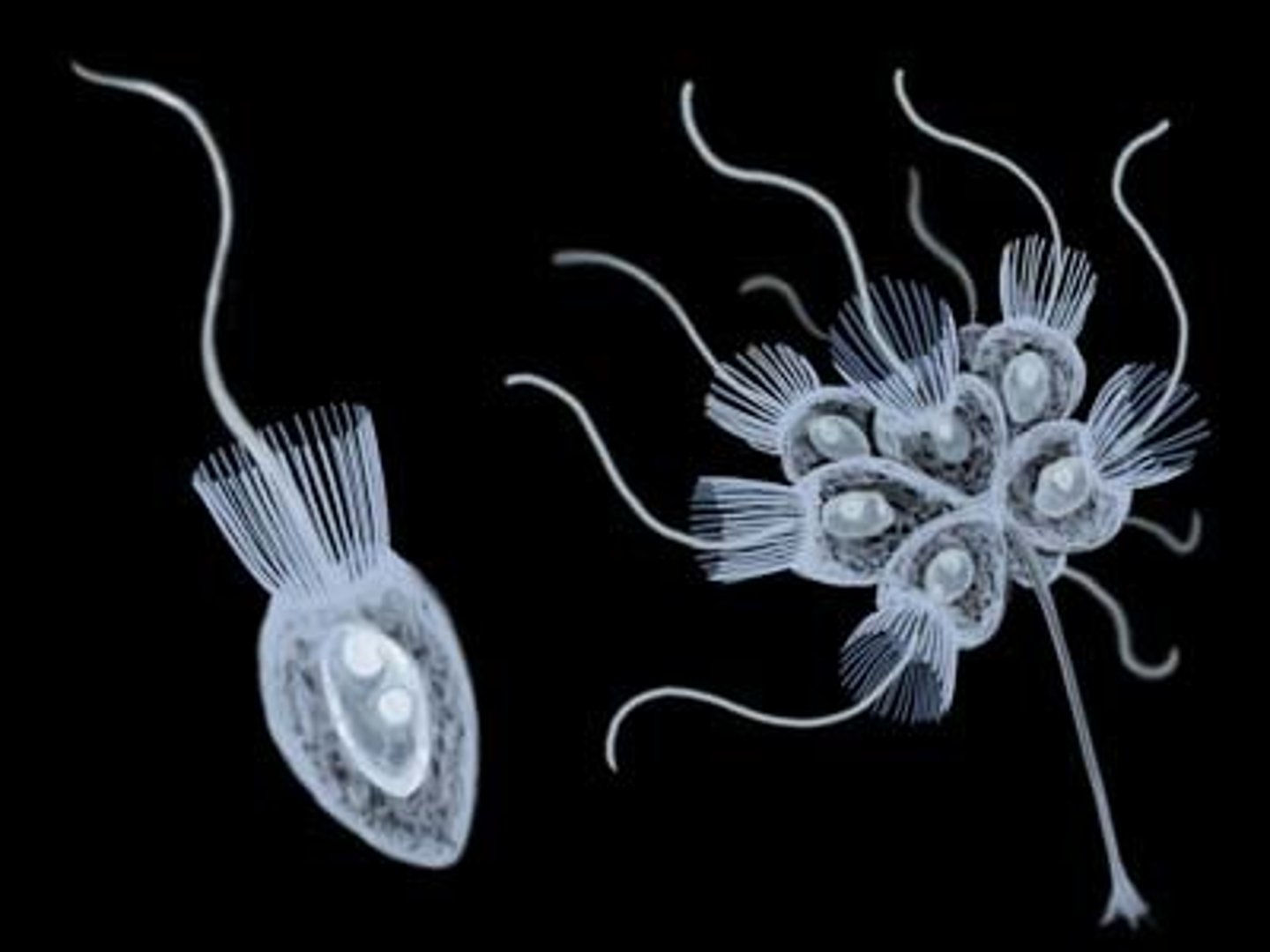
Amoebozoa
Slime Molds. Many nuclei within one giant cell, can solve mazes, dispersal, can identify optimal path with no brain
grex
when a thousand Amoebozoa aggregate into multicellular slug-like form to migrate and forage
Archaeplastida
the supergroup that includes red algae, green algae, and land plants
red algae can fight of viral infection with manose-binding lectins and give mice immunity to ebola
Stramenopiles
Clade of protists with "hairy" flagellum includes water molds, diatoms, and brown algae. DIATOMS
Alveolates
Dinoflagellates:
- bioluminesence
- flagelated
- red tides: potential toxins
- CHAOS REAGENT
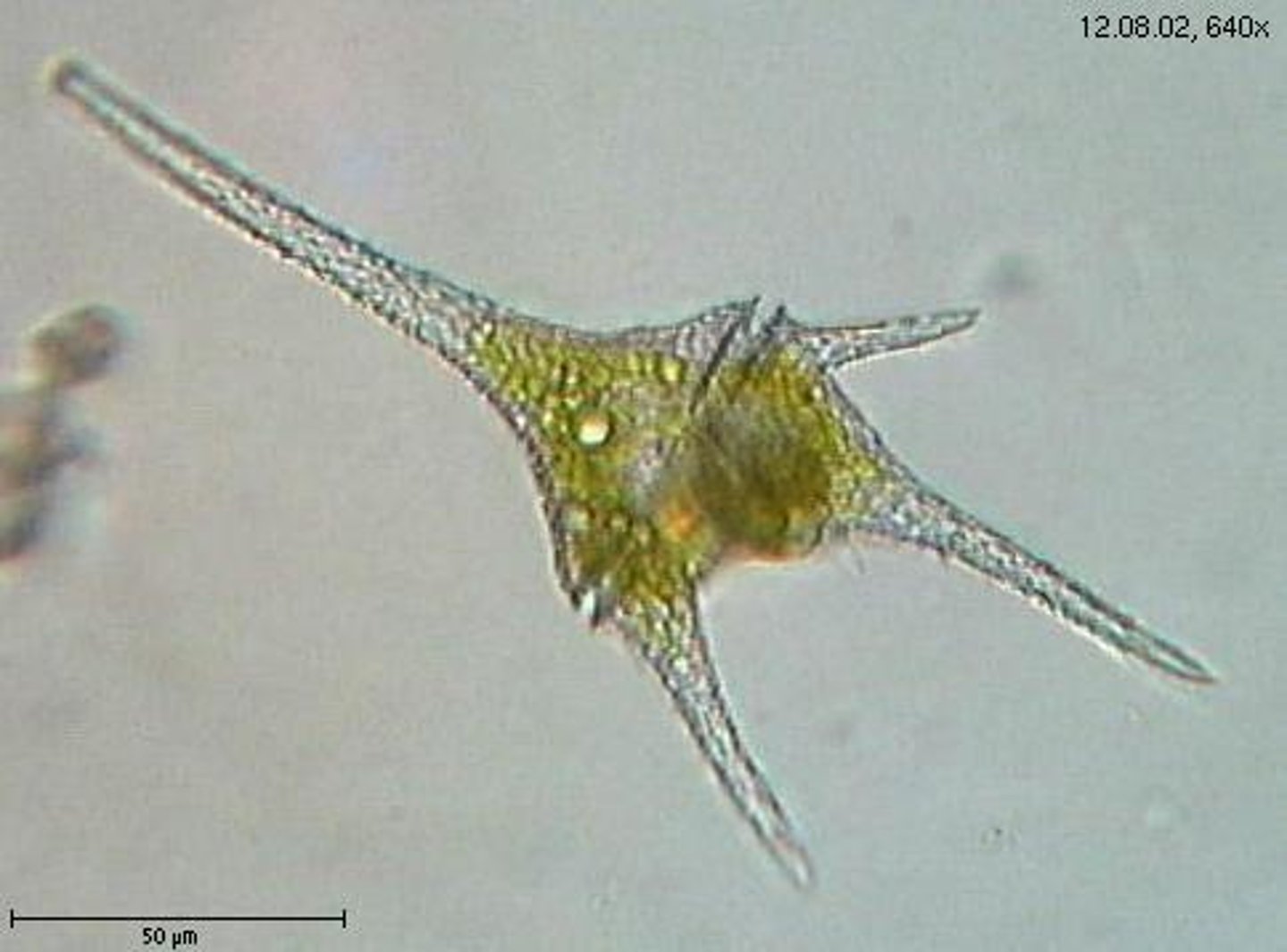
Rhizarians
- unicellular and heterotrophic
- built intricate shells or skeletons
- Forams: calcium carbonate, Radiolaria: silica
- important stratigraphic marker
- bioindicators
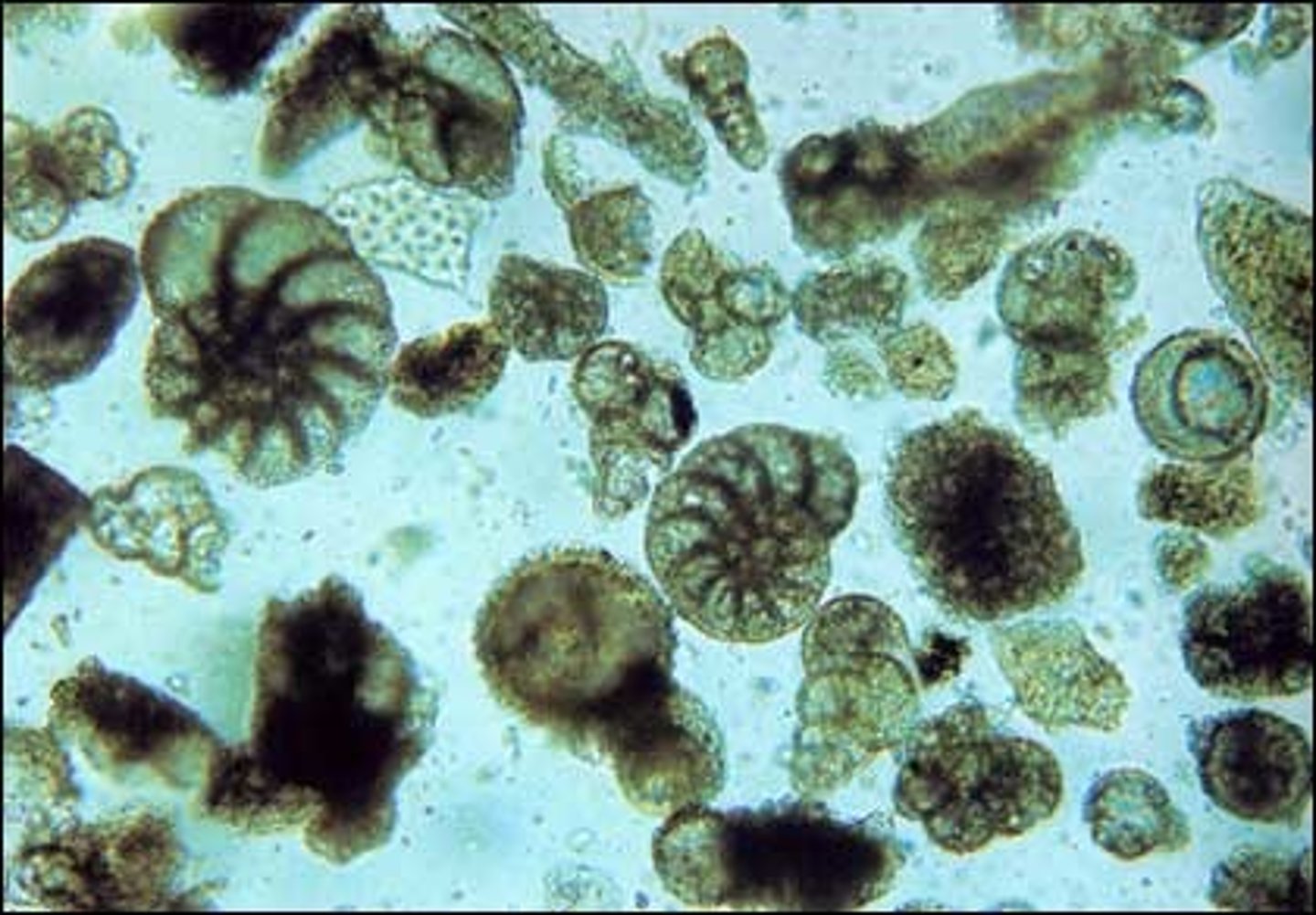
How will plant science help deal with malnutirution statistics and projected population growth?
Increase drought tolerance in plants
Decrease fertilizer requirements
Increase pathogen resistance
Increase nutritive quality
Why are plants important?
1.Oxygen production
2.Carbon sink
3.Hold soils and slow down runoff
4. The ultimate primary producers
Four key evolutionary events in the history of evolution in plant life:
1. Origin of Chloroplasts
2. Ability to live on land (water--> CO2 trade off)
3.
Role of cuticle in plants
limits water loss
What does the stomata do?
enables the exchange of gases (transpiration)
lignin
very strong complex plymer in plants that allows them to live outside of water
Evapotranspiration
water exiting the plant via the stomata is what drives the movement of water from the roots to the very top of the plant. Driven by the sun
Seeds for dispersal without drying out in the water.
•Includes an embryo and nutrients encapsulated into a tough coat
•Dormancy ensures that seeds do not germinate until conditions are favorable
•Effective way to disperse the next generation
diploid sporophyte
produces haploid spores by meiosis
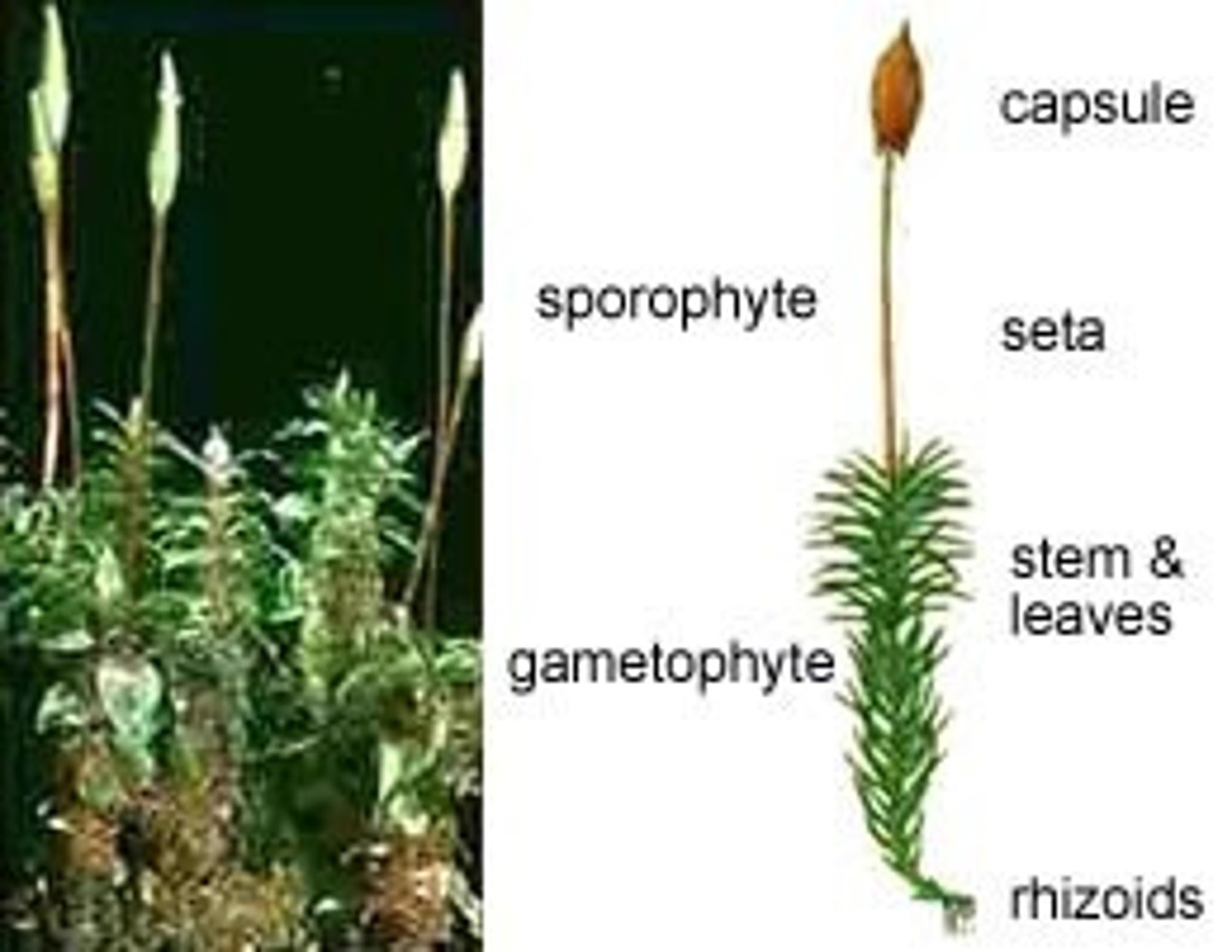
Haploid Gameophyte
The life stage that produces gametes through mitosis (normal green plant
Angiosperms
flowering plants count for 92% of plant species
Why so many angiosperms?
Abiotic forces drove early transition and adaptation to land
Flowers and seeds created ecological opportunity and morphological innovations for biotic interactions
Mangrove trees show what
Adaptations for success in marine water
Aerial roots for gas exchange
Salt excretion on leaves at subaxial stomata
Thick, waxy Casparian strip in roots excludes salt
Strategy for reproduction in inhospitable environment
Embryo development on plant (viviparity)
Diversity in seed dispersal mechanisms
from fruits that attract dispersers, to different shapes on the seeds to promote attaching to passing animals
Why study fungi?
1. Important in food production, alcohol production, breads. Also responsible for food spoliage, black mold (public risk).
2. Effects on humans and food from minor to major. How to extend shelf life?
3. Infectious agents, yeast and atheles foot and building mold.
4. found in medical prescriptions (pennicilian, and many others)
Basic Characteristics of Fungi
Absorptive Feeding Heterotrophs.
Saprophytic: eat dead or decaying matter.
Cordyceps Fungi
Slow growing fungus that eats away at an insect's exoskeleton then digests insect's soft tissue until it dies. Makes the ant (or other species) crawl to a high point before sprouting from it's brain.
Chytrid Fungi
Fungi that attaches to organic matter by rhizoids; can degrade keratin layer of amphibian skin. This is catasrophic to amphibians.
Mycorrhizae
Plant root surface area for better mineral access, while the plant supplies sugars to fuel fungal growth, with species either staying outside root cells (EMF) or penetrating into them (AMF). Mutualistic Relationship between fungi and plant.
Lichens
Mutualism between fungi and photosynthetic cyanobacteria, the cyanobacteria provide sugars from photosynthesis while the fungi supply nitrogen and phosphorus from the substrate, such as wood or rock.
What is spanish moss?
Angiosperm. It is an epiphyte - a plant that grows on another plant. It is NOT parasitic, but commensal. Does not harm the host tree.
saprophytic fungi
Fungi that get their energy from decaying organic matter.
Can break down lignin peroxidase and cellulase, can break down molecules that no other species can.
Great decomposers
Speed up Carbon Cycling
How do we study fungal diversity?
Morphospecies concept (100,000 species) and Ribosomal gene sequencing(6 MILLION-12 MILLION species)
Challenging group to assess when it comes to diversity.
Mycelium
network of thread-like structures called hyphae that make up the vegetative part of a fungus. They grow through and digest organic material, playing a key role in nutrient cycling and decomposition.
Nematode-trapping Fungi (Arthrobotrys)
A predatory fungi that captures and consumes nematodes. It forms specialized hyphal traps, constricting rings, to ensnare nematodes and then digests them for nutrients, especially nitrogen.
Features of mycelia
Passive transport of water, solutes, nutrients.
100X smaller than plant roots, about 10µm diameter.
Large surface area, efficient at nutrient absorption.
Susceptible to desiccation (drying out) - found in moist habitats.
fungi and animal similarities
Chitin – in fungal cell walls; in animal exoskeletons
Flagella – in chytrid spores; in animal sperm
Glycogen – energy storage molecule in fungi and animals. Plants use starches.
Are slime molds fungi or protists?
PROTISTS
Opisthokonta
Animals, fungi, choanoflagellates
Most likely common ancestor of all animals?
Most likely a colonial flagellated protist (perhaps resembling modern choanoflagellates)
Cambrian Explosion
(542 - 525 mya) rapid diversification of most major animal groups marking the start of the Paleozoic era